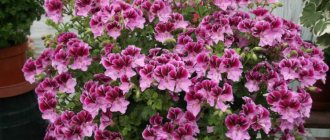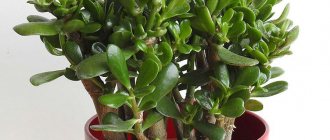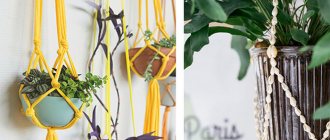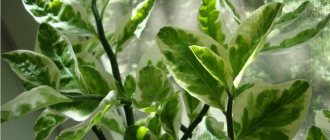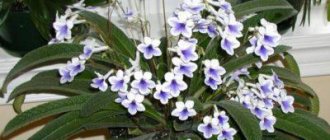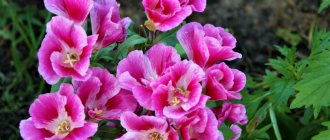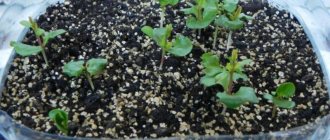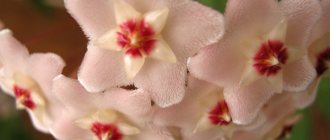- home
- Plant care
>
Azalea Roses Violets Lilies Anthurium Orchid Begonia Fuchsia Croton (codiaum) Palms Gerbera Coffee tree Lemon Cyclamen Aloe Decembrist Caring for potted plants Celosia Narcissus Saintpaulia Fittonia Plumeria Cissus Orange Strobilanthes Boxwood Neomarica
Indoor plants are amazing representatives of the flora. In response to care and careful attitude, they respond with beautiful flowering and delight with elastic green foliage. It doesn’t matter how they came to you: whether they were a gift or purchased, without proper care, houseplants will stop blooming and wither.
There are no trifles in caring for flowers in a pot:
- They are sensitive to room temperature, lighting, humidity and other conditions.
- It is important to water them on time, cut off dry leaves, feed them, and spray them.
The company's specialists urge: be responsible when leaving for a long time on trips or business trips. Even a week's absence of watering or spraying is a test for green “pets”.
We, as a company that has been working in the field of servicing indoor plants for many years, offer flower care services. If individuals or organizations entrust watering, replanting, and fertilizing to our specialists, they can be sure that the service will be provided at a high level.
Rules of care
In winter and summer, caring for indoor plants has its own characteristics:
- Winter is a dormant period for potted flowers. All processes in them slow down, so they need to be watered less often. Feeding is not required at all and the need for a large amount of light (for example, for light-loving varieties) also disappears. But at this time, do not forget to remove dried leaves and monitor whether diseases have appeared.
- With the onset of spring, the flowers “wake up”, begin to bloom, and there is a need for feeding them, frequent watering and spraying. Their service begins to operate as normal.
To make flowers comfortable, it is necessary to create favorable conditions: the desired temperature, humidity and light level.
Original use cases
Fashion is dictated by new trends and trends, including the cultivation of indoor plants. I would like to draw your attention to three options for using vegetation in interior design - vertical gardening, home rock garden and florarium.
Vertical gardening
Unfortunately, the parameters of many apartments do not allow for growing a large number of plants. You can add gorgeous greenery to your room without taking up much space at all. A composition of decorative foliage and flowering plants on the wall can be compared to a living painting .
“Living picture” on your wall
Vertical floral compositions are usually placed in corners and partitions, as well as free walls are dedicated to them. “Green panel” can decorate any apartment, even a small one-room apartment.
Phytowall in one-room studio
For its appearance at home, I can recommend the following plants:
- decorative varieties of red-leaved aglaonema;
- low-growing varieties of spathiphyllium,
- variegated and green-leaved fatsias;
- varieties of medium-sized and dwarf ferns;
- all varieties of chlorophytums;
- low-growing sansevieria;
- hoya;
- calathea;
- coleus (decorative speck);
- ampelous plants.
An interesting solution for any apartment
The vertical gardening method is not a cheap pleasure. In addition to financial investments, it requires regular, competent and painstaking care. I recommend it to be used only by experienced gardeners.
.
Florarium
For lovers of aesthetics, exoticism and minimalism, I can recommend growing plants in a florarium. This activity is fashionable and very exciting. It doesn’t require a lot of investment or time, and it looks visually beautiful.
Aesthetics and minimalism in one bowl
The florarium is called a mini-garden behind glass. As a basis for growing it, you can take an ordinary aquarium or other glass container. With its help, it is not difficult to give up growing exotic flowers in ordinary pots.
Mini garden behind glass
Group compositions of slow-growing plants are planted in a miniature flower garden. Among the most popular:
- ferns (polygonium, asplenium and pteris);
- sphagnum moss;
- ivy;
- small succulents;
- cacti;
- orchid;
- cyclamen;
- Saintpaulia.
Miniature slow growing indoor plants
Creating a florarium requires the right combination of plants, compliance with the general habitat and growing conditions.
Home rock garden
Not everyone can own a greenhouse or winter garden, but they still want to create a piece of living nature and come into contact with beauty. If you like this idea, then I advise you to prepare a place for a home rock garden.
Homemade flowers framed by natural stone, with the melodious murmur of water and decorative lighting - this is what you need. The rock garden will become a real highlight of the interior and your pride .
The highlight of the interior in your home
Its advantage is that the design can be adjusted by replacing or rearranging plants. There are no clear recommendations for populating a home rock garden. The main thing is to respect its geometric shapes and follow the principle from small to large .
Geometric lines when planting plants
Here I propose to show maximum imagination and improvise with tropical, exotic and the most common, decorative deciduous and flowering representatives of the flora (the only exception is cacti). A canary cage or an aquarium will help bring your paradise to life.
A home rock garden is a complex and monumental structure. It will require serious work and financial investments. However, the fantastic result of the creation justifies all the work and expense.
A lot of work in creating a masterpiece
Indoor plants give us positive emotions and help to establish inner harmony of the soul. You can talk endlessly about houseplants in the interior, no matter how amazing and beautiful they are.
TOP 5 best fertilizers for indoor plants
1BioMaster
It is produced in liquid form and has a wide range of products intended for different types of indoor plants.
2"Meister Agro"
In the form of granules it has several types, including a universal one, suitable for most types of indoor plants
3"Florist Micro"
A universal type of fertilizer, which contains the entire set of necessary chemical elements, can be used for any indoor plants
4"Tsitovit"
It is a complex microfertilizer in organic form, which contains virtually all the substances necessary for development and growth
5 "E-Alpha"
VIDEO: The most beautiful flowers for your home
Flowers at home
Updating the interior with indoor plants
Temperature
Beginning gardeners are sure that the warmer the room, the better for the stems and leaves. This opinion has a basis: indoor flowers come from the tropics and their ancestors grew in humid and warm conditions. Despite this, many potted flowers thrive at temperatures up to 24 degrees. Even heat-loving specimens need at least 16 degrees in winter. If 17-18 degrees is not entirely comfortable for a person, then for these plants it is optimal.
The main rules for caring for indoor plants:
- Ensure the temperature in the room where they grow is no more than 24 degrees.
- Avoid temperature differences of more than 6 degrees. If the pot is on the windowsill, then in frosty weather it is better to remove it from there. On a note! Only cacti are not afraid of such changes, because their ancestors grew in deserts, where day and night temperatures differ several times.
- Create a temperature in winter of no more than 13-15 degrees so that your green “pets” experience the rest period they need. So, eucalyptus will thrive even at 5 degrees above zero.
Important! Soil temperature also matters. It is usually a couple of degrees lower than the air temperature, so it is important to protect the flower roots from hypothermia. What to do? Do not place the pot close to the glass when it is cold outside. Another solution is to place the pot on a “mat” made of foam, cork or cardboard.
We germinate the seeds
To increase germination and strengthen the future plant before sowing, treat the seeds as follows: wrap them in gauze and dip them in water with an added growth stimulant. The soaking period depends on the size of the seeds - from 1 to 3 days.
Situations often arise that after planting the seeds in the ground, all the deadlines have passed, but the seedlings do not appear. To avoid this, when preparing seeds for sowing, stratify them. Simply put, put them in the refrigerator at a temperature below 5 degrees and keep them there for several days.
If the seeds have a thick seed coat, it may prevent them from germinating. In this case, soak them in water and carefully peel off the thick skin.
Light mode
Caring for house plants also means creating the right level of lighting. Two criteria are important in it: intensity and duration.
- In spring and summer, during the period of active growth, flowers should be illuminated for at least 16 hours a day. If flowers constantly experience a lack of light (this is possible even with a lighting duration of 10 hours or less), then the synthesis of nutrients in them will slow down.
- To provide intense lighting, you need to place pots in rooms with southern, western or eastern windows, and avoid placing them in the corners of the room. If the room has windows facing north, lighting is required. Without it, only ferns, ivy, and cyclamen can grow successfully.
- Flowering specimens need more light.
- Being under direct sunny windows is harmful for indoor “pets”. If the windows face south and the pots are on the windowsill, then according to the rules for caring for indoor flowers, it is necessary to reduce the light intensity by attaching paper to the glass or hanging a transparent curtain.
As part of this, we not only take care of the flowers, but also give recommendations on adjusting the light intensity, on the correct placement of pots within the room, taking into account the requirements of a particular type of plant for the level of illumination.
Preparing flower seeds for planting
It is better to start your experiments with simple annuals. The main requirement for seeding material: the seeds must be fresh and disinfected. Sow seeds that take a long time to germinate in winter, and those that germinate quickly - in March-April.
For seeds that have a long germination period, I recommend the following methods of stimulation:
- soak the seeds in water before planting;
- pour boiling water over it;
- make small neat cuts on each seed (if the seeds are not too small);
- soak the seeds in pre-settled aloe juice.
Be sure to disinfect the soil for sowing: pour boiling water over the soil twice or heat the soil mixture in a water bath or in the microwave.
Attention! This cannot be done when sowing seeds of heather plants.
- Zonal pelargonium from seeds - how to sow so that you can avoid picking the seedlings for a longer time?
Sow seeds in pots or trays.
Air humidity
Caring for indoor flowers in low humidity conditions is difficult. Even abundant watering will not give results: the plant will drop its buds and stop growing. To increase humidity, we recommend using several methods:
- Install a humidifier.
- Spray regularly (during the growth period this can be done both in the morning and in the evening). This care should be carried out before the first rays of the sun fall on the pot.
- Use a tray with water.
- Cover heating radiators with wet towels (the method is effective if flower pots are on the windowsill directly above the radiators).
When servicing flowers, the main thing is not to overdo it, because excess moisture in the air (especially in combination with low temperature) is fraught with another problem - rotting.
Which flowers to choose for growing at home
When choosing flower seeds, you should consider several very important conditions:
- first of all, flowers, of course, should be attractive to you;
- second condition: the shape and color of the flowers should be in harmony with your home interior. Harmony always has a beneficial effect on the emotional background in the house;
- third condition: be sure to take into account the degree of illumination of the place in which the flowers will be located. It is not always possible to provide them with what they need. Therefore, when you choose seeds, carefully read the plant's light requirements.
When purchasing, pay attention to the availability of GOSTs, expiration date and manufacturer - it must be reliable.
Feeding indoor plants
Providing flowers with enough nutrients is another important task in their maintenance. In winter they do not need feeding, but in the spring and summer months it is recommended to use mineral fertilizers at least 3 times:
- in the spring, when the dormant period has ended;
- before the formation of buds;
- after flowering is complete.
will take care of all the care of potted plants. We work with organizations and individuals. To view prices for services or get advice, call us by phone.
Prices for plant care.
| Plant care (for organizations) | Things | Cost of service per month | Note |
| Height up to 70 cm. | 1 | 450 rub. | The price includes all necessary procedures and medications |
| Height up to 1.5 meters | 1 | 550 rub. | |
| Height up to 2.5 meters | 1 | 750 rub. | |
| Height from 2.5 meters | 1 | 1,000 rub. | |
| A discount is provided based on the number of plants served | |||
All prices include VAT.
Leave a request for services
your name
Telephone
By submitting data I accept the terms of the user agreement
Send
Sow seeds and care for crops
If the seeds are small, then they are not deepened into the soil, but only laid out on its surface. Spread them evenly and spray them with a well-dispersing spray bottle, cover with film or glass. Medium-sized planting material is planted to a depth of 1-2 mm, large - to a depth of 1-2 cm. If you follow the folk wisdom accumulated over centuries, then the depth should be equal to the diameter of the seed material.
If you soak the soil well with water before and after planting and cover it thoroughly after sowing, then watering before emergence will not be necessary. But, if the soil still becomes dry, then spray it carefully. Do not allow large amounts of condensation to accumulate on the film. Many large drops are a sign of overheating. Remove excess moisture in a timely manner and lightly ventilate the crops.
Reviews
Natalia, 25 years old
I really love being surrounded by living plants. Renting at home is much more comfortable. But as soon as I think about the planned fertilization and replanting, panic begins. I am very glad that I can only enjoy the beauty of indoor plants, and entrust their care to professionals from. All manipulations with my green “friends” are performed simply masterfully – as quickly and efficiently as possible!
Evgeniya, 43 years old
Just recently, all the finishing work in the house was completed, and that long-awaited moment came when I was able to direct all my efforts to improving the yard. I thought that, armed with advice from the Internet, I could quickly cope with this task. It turned out that landscaping requires deep knowledge and specialized equipment. I didn’t dare to ruin my dream of an ideal courtyard, so I started creating it. Thank you very much for the work done!
Tatyana, 58 years old
I have a fairly large house and every room is surrounded by decorative flowers. Every year it becomes more and more difficult to care for them, especially since my collection is constantly replenished with new specimens. So that many years of efforts would not be in vain, I decided to ask for help. A friend recommended visiting the website serissa.ru. I was pleasantly surprised by the variety of the company's services and its affordable prices. Now I don't have to worry about my flowers losing their attractiveness.
You can find a complete list of reviews in the reviews section.
Diseases and pests
Often violets are affected by various diseases and caring for them in this case becomes more complicated.
Putrefactive bacteria on leaves
The disease occurs due to excessive watering or pests contained in improperly prepared soil.
Required:
- remove all rotten leaves;
- treat the violet with a fungicide;
- disinfect with phytosporin.
Root rot
A fungal disease that develops in low-acid, highly moist soil.
You need to stop watering , the fungus will die in dry soil. The roots are treated with phytosporin .
Powdery mildew
The disease occurs due to low temperature and high humidity . Most often, recently transplanted violets become infected with powdery mildew.
The plant is treated with an antifungal drug and transferred to more favorable conditions.
Powdery mildew.
Late blight
Caused by the late blight fungus.
At the initial stage of late blight, violets can be saved :
- Cut off all damaged foliage and some roots;
- The plant is transplanted into sterile soil;
- Treated with antifungal agents.
Fusarium
An infectious disease caused by a sharp drop in temperature or watering with cold water :
- the disease leads to the death of the plant;
- the flower along with the soil is disposed of;
- the pot is disinfected to remove harmful bacteria.
Bronzing
A virus carried by parasites - thrips.
The plant is treated with insecticides and antiviral drugs .
Insects - pests
These include:
- aphid;
- mites;
- scale insect;
- mealybug;
- nematodes.
The plant and soil are treated with insecticidal agents.
Choosing a plant depending on the light
It is very important to choose the right place for an indoor flower. Potted plants are demanding on light and ambient temperature. Flowers can be sun-loving, shade-growing, or unpretentious.
The amount of nutrients produced depends on light, and deficiency affects the health of the plant.
Heat-loving flowers wither from the cold and shed their leaves. The average temperature regime is 17–22 °C. On long winter evenings, tropical plants need lighting.
Light-loving flowers
The window sill of the south window and the space nearby are ideal for the following plant varieties:
- verbena;
- zinnias;
- tuberous begonia;
- Cyperus;
- ficus;
- geraniums;
- Kalanchoe;
- anthurium;
- dracaena;
- Calathea.
Indoor plants growing in the shade
If your apartment windows face north, grow species that do not require a lot of sunlight:
- zamioculcas and fuchsia;
- chlorophytum;
- hatsia;
- monstera;
- aspidistra;
- nephrolepis or sansevieria;
- fatsia;
- hederu.
Unpretentious
It is better for novice gardeners to gain experience on plants that are undemanding in terms of lighting:
- hoye;
- Crassula;
- bokarnee;
- scindapsus or tradescantia;
- cactus;
- fern;
- canna and caladium;
- coleus.
Love and attention
The best way to keep your plant in tip-top shape is to care for it regularly, with care and love.
Some little things , such as removing wilted flowers that take away the plant's strength, or removing dried leaves will prolong flowering and protect the plant from rot and mold, respectively. Scissors for such purposes should always be sharp and clean.
A loving gardener tries to learn as much as possible about each of his plants and care for them as best as possible.
Preparing for winter in the fall
From September to October, the days are shorter, the weather changes, and it becomes colder. From this time on, indoor flowerpots must begin to be switched to winter mode. During the cold season, the vegetative processes of most deciduous plants slow down, and in some they stop altogether. For the winter, deciduous flowerpots are put away in a dark, cool place from the end of autumn, where they wait for spring.
To prevent flowers from experiencing stress from sudden changes in growing conditions and cold, they can be helped to “get ready to relax.” To do this, they stop feeding them, especially with nitrogen-containing fertilizers, water less frequently, moisten them and protect them from drafts.
Plants that need rest for the winter
Most bulbous and all tuberous flowers must go through winter dormancy. In autumn, their leaves naturally turn yellow and fall off or wither; you need to wait for this process and then cut the stems, leaving 2 - 3 cm.
Among the cold-loving ones, flowering ones are distinguished: tuberous begonia, fuchsia, hippeastrum, hydrangea, gloxinia, hyacinths and others.
After pruning, the plant must be treated with solutions of fungicides and insecticides to destroy and prevent diseases, fungi and pests. The roots are then stripped or left in the pot and transferred to a cool, dark place for storage. The temperature is about +5 - +10, and the roots need to be moistened periodically so that they do not dry out. Avoid overwatering, otherwise they will rot and die.
